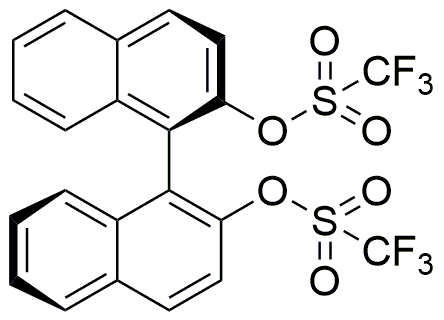(R)-(-)-1,1'-Binaphthyl-2,2'-diyl bis(trifluoromethanesulfonate) is widely utilized in research focused on:
- Asymmetric Synthesis: This compound serves as a chiral auxiliary in asymmetric synthesis, enabling chemists to create specific enantiomers of molecules, which is crucial in pharmaceuticals where the efficacy of a drug can depend on its chirality.
- Catalysis: It is used in catalytic reactions, particularly in the production of fine chemicals. Its unique structure allows for enhanced reaction rates and selectivity, making it valuable in industrial applications.
- Material Science: This chemical is applied in developing advanced materials, such as polymers and coatings, that require specific optical or electronic properties, benefiting industries like electronics and coatings.
- Research in Organocatalysis: It plays a significant role in organocatalysis, where it helps facilitate reactions without the need for metal catalysts, offering a greener alternative in organic synthesis.
- Pharmaceutical Development: The compound is explored for its potential in drug formulation, particularly in enhancing the solubility and bioavailability of active pharmaceutical ingredients, addressing common challenges in drug delivery.
General Information
Properties
Safety and Regulations
Applications
(R)-(-)-1,1'-Binaphthyl-2,2'-diyl bis(trifluoromethanesulfonate) is widely utilized in research focused on:
- Asymmetric Synthesis: This compound serves as a chiral auxiliary in asymmetric synthesis, enabling chemists to create specific enantiomers of molecules, which is crucial in pharmaceuticals where the efficacy of a drug can depend on its chirality.
- Catalysis: It is used in catalytic reactions, particularly in the production of fine chemicals. Its unique structure allows for enhanced reaction rates and selectivity, making it valuable in industrial applications.
- Material Science: This chemical is applied in developing advanced materials, such as polymers and coatings, that require specific optical or electronic properties, benefiting industries like electronics and coatings.
- Research in Organocatalysis: It plays a significant role in organocatalysis, where it helps facilitate reactions without the need for metal catalysts, offering a greener alternative in organic synthesis.
- Pharmaceutical Development: The compound is explored for its potential in drug formulation, particularly in enhancing the solubility and bioavailability of active pharmaceutical ingredients, addressing common challenges in drug delivery.
Documents
Safety Data Sheets (SDS)
The SDS provides comprehensive safety information on handling, storage, and disposal of the product.
Product Specification (PS)
The PS provides a comprehensive breakdown of the product’s properties, including chemical composition, physical state, purity, and storage requirements. It also details acceptable quality ranges and the product's intended applications.
Certificates of Analysis (COA)
Search for Certificates of Analysis (COA) by entering the products Lot Number. Lot and Batch Numbers can be found on a product’s label following the words ‘Lot’ or ‘Batch’.
*Catalog Number
*Lot Number
Certificates Of Origin (COO)
This COO confirms the country where the product was manufactured, and also details the materials and components used in it and whether it is derived from natural, synthetic, or other specific sources. This certificate may be required for customs, trade, and regulatory compliance.
*Catalog Number
*Lot Number
Safety Data Sheets (SDS)
The SDS provides comprehensive safety information on handling, storage, and disposal of the product.
DownloadProduct Specification (PS)
The PS provides a comprehensive breakdown of the product’s properties, including chemical composition, physical state, purity, and storage requirements. It also details acceptable quality ranges and the product's intended applications.
DownloadCertificates of Analysis (COA)
Search for Certificates of Analysis (COA) by entering the products Lot Number. Lot and Batch Numbers can be found on a product’s label following the words ‘Lot’ or ‘Batch’.
*Catalog Number
*Lot Number
Certificates Of Origin (COO)
This COO confirms the country where the product was manufactured, and also details the materials and components used in it and whether it is derived from natural, synthetic, or other specific sources. This certificate may be required for customs, trade, and regulatory compliance.


